Tax hikes ahead. Time to accelerate dividend payments?
Loading...
Regardless of the outcome of the fiscal cliff negotiations, taxes on dividends will be higher in 2013 than in 2012. As a result, companies can save some shareholders plenty of taxes by paying some of next year’s dividends this year.
But not every shareholder will benefit from this presumed largess. While the very wealthy will be winners, many middle-income investors could be worse off.
For instance, that extra dividend income could throw some shareholders onto the alternative minimum tax. Some retirees could see more of their Social Security benefits subject to income tax. Some families with children will pay more tax as their child credits phase out.
While some investors would be hurt by the accelerated dividend payouts, many low- and middle-income taxpayers could benefit. Taxpayers in the 15 percent bracket and below will owe no income tax on 2012 dividends but would pay their ordinary tax rate on 2013 dividends if Congress doesn’t act. That includes many retirees who rely on dividend income to support themselves.
Two tax increases are scheduled to hit dividends next year:
- New taxes associated with Obamacare will kick in for high-income households. Dividends will be subject to a new 3.8 percent tax on investment income above a threshold—$250,000 for couples and $200,000 for singles.*
- Tax rates for dividends revert to ordinary rates as high as 39.6 percent, up from the current top rate of 15 percent.
The first tax hike is certain. The second is tangled up in fiscal cliff negotiations and will occur if Congress and the president do not agree to extend current tax rates for dividends. Even a compromise could raise taxes on dividends for high-income taxpayers.
Some dividend-paying companies are doing their wealthier shareholders a big favor by paying some of their 2013 dividends in 2012. High-income taxpayers will pay a 2012 tax at a rate that is at least 3.8 percentage points lower, and possibly nearly 30 percentage points lower, than they would pay on 2013 dividends.
Some big companies have shifted their January dividend payments back to this month. For example, Wal-Mart, nearly half of which is still owned by members of the Walton family, moved its quarterly dividend from January 2 to December 27. Even if Congress extends all of the 2001-2010 tax cuts, Walton family shareholders alone stand to save at least $20 million in income tax because of the early payment.
Costco went its competitor one better, borrowing $3.5 billion at today’s rock-bottom interest rates so it could pay its shareholders a $7-a-share special dividend. After federal income tax, that’s worth more than $5.40 a share to even the highest-income recipients. If Costco paid that dividend next year and we go over the fiscal cliff, high-income shareholders would net about a quarter less.
We’ll never really know why firms accelerated their dividend payments. The new Obamacare taxes alone might have been a big enough inducement. Or perhaps they were driven by the threat of going over the fiscal cliff. But the important thing to keep in mind is this is little more than the kind of timing change that often occurs when tax rates are adjusted. It may bump up federal revenues for tax year 2012, and knock them back a bit in tax year 2013. But five years from now, it will all be lost in the economic noise. The only people who will remember may be those unlucky investors who ended up paying more tax in 2012 than they expected.
* The 3.8 percent tax actually applies to the lesser of investment income and the amount by which adjusted gross income exceeds the $250,000 or $200,000 thresholds. Thus, a couple with $300,000 of earnings would pay the tax on all of their investment income, while a couple with $225, 000 of earnings and $100,000 of investment income would pay the tax on $75,000—the first $25,000 would be income below the cap.







